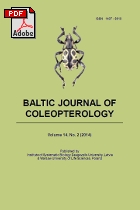Trophic preferences ofHarpalus rufipes (Coleoptera, Carabidae) with regard to seeds of agricultural crops in conditions of laboratory experiment
Main Article Content
Keywords
:
food consumption, body mass, phytophage, polyphage
Abstract
Our research fills an important gap by making a quantitative assessment of the trophic preferences of a widespread, abundant species, Harpalus rufipes (De Geer, 1774) in laboratory conditions. We conducted three types of 5-day laboratory experiment in which 1, 5 and 15 species of seeds of agricultural crops commonly consumed by the beetle within the Ukrainian part of its range were offered. The H. rufipes imagines were kept in plastic containers and the changes in weight of the food and changes in weight of the imagines were measured. When beetles were offered only one type of food the average consumption was 52.9 ± 24.9 mg/day per specimen for the seeds of Fagopyrum esculentum Moench, 40.6 ± 2.9 for Beta vulgaris L. and 40.8 ± 24.8 mg/day per specimen for Helianthus annuus L. Significant amounts (19.1-34.0 mg/day per specimen) of other seeds offered were consumed. The least consumed were Hordeum vulgare L. (10.0 ± 4.5 mg/day per specimen), Secale cereale L. (9.6 ± 4.0), Sorghum drummondii (Steud.) Millsp. & Chase (11.8 ± 4.1) and Papaver somniferum L. (16.0 ± 7.9). On average with a choice of seeds of 15 agricultural crops, a single H. rufipes beetle consumed 62.4 ± 9.1 mg per day, that is 2.46 times more than average consumption across seeds in the experiment with only one species of food plant. In free choice conditions the average weight of beetles rose only by 1.9 ± 1.7 times in 24 hours. The consumption by H. rufipes imagines of agricultural seeds in free choice conditions is presented as follows in declining order of preference, measured as mg/day per specimen: Avena sativa (7.1 ± 3.5), Triticum aestivum (6.9 ± 2.9), Panicum miliaceum (6.3 ± 2.4), F. esculentum (5.9 ± 2.7), S. cereale (5.1 ± 2.8), S. drummondii (5.0 ± 3.0), Cannabis sativa (4.2 ± 3.2), Brassica napus (3.5 ± 2.7), Sinapis arvensis (3.4 ± 1.7), Beta vulgaris (3.3 ± 1.4), Juglans regia (3.0 ± 1.5), Hordeum vulgare (2.9 ± 2.3), Papaver somniferum (2.7 ± 2.3), Helianthus annuus (2.3 ± 0.4) and Arachis hypogaea (0.9 ± 0.5). For keeping H. rufipes in laboratory conditions 5 variants of mixed diet, each consisting of 5 plant species, were tested: the first mostly carbohydrate, the others with average and high content of fat. Out of these diets only the carbohydrate diet involved a significantly higher level of food consumption. It contained seeds of T. aestivum, A. sativa, S. cereale, F. esculentum, B. vulgaris. When different multicomponent diets were offered the consumption of different types of food varied by 1.5 to 2.0 times.
Article Details
Statistics
Downloads
Download data is not yet available.
Recommend Articles
